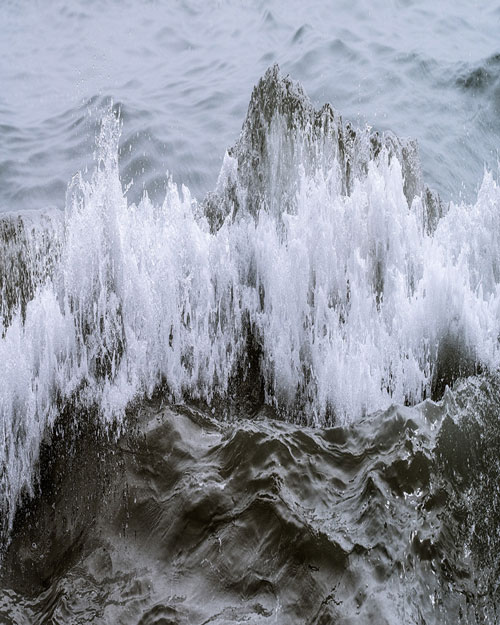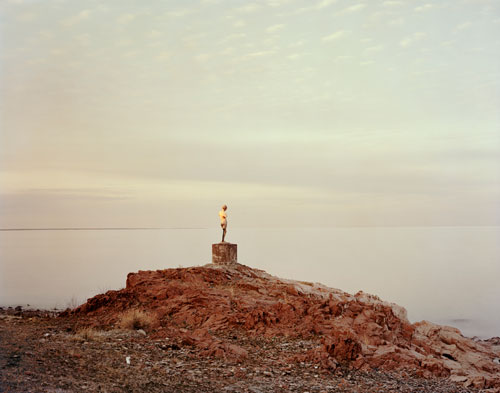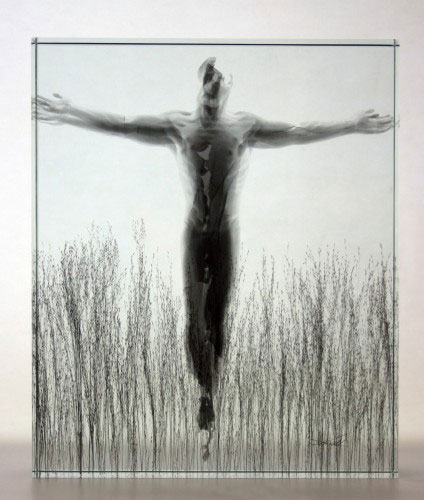Your cart is currently empty!
A Guide to Paris Photo LA, 2015

An interview with Paris Photo LA’s new director, Florence Bourgeois, and the new artistic director, Christoph Wiesner, was the first thing on my agenda for the fair this year. I wanted to get from Bourgeois and Wiesner a sense of what changes or innovations they hope to bring to PPLA. Because this is the third year of the three-year commitment Paris Photo had made to be at Paramount Studio in LA, I also wanted to find out whether a decision had been made yet to renew the contract.
Ms. Bourgeois was very forthcoming about this last question. Yes, she said, the fair would definitely be back next year. “Paris Photo has to have iconic places,” she continued, “– the Gran Palais in Paris, and the Paramount Studio here. The fair works because the venue is fantastic. It’s an experience to come here radically different from that of any other fair in the world.” She was less certain about whether the new contract was also for three years or just one, but was definite that PPLA would be on-going.

Sliver 7, 2014
Framed Ultrachrome Archival Pigment Photograph with UV Coating
Artist and ACME., Los Angeles
Exhibitor : Acme
Mr. Wiesner responded to my original question about new initiatives, elaborating on two they have already taken. One is “Introducing! Young California Photographers Award,” which is an annual competition sponsored by Paris Photo LA sponsor J.P Morgan Bank. The other he mentioned is “California Unedited! The Archives of R. J. Arnold,” which is an exhibition of new prints from the restored negatives of a 19th-century portrait studio in Paso Robles. Bourgeois elaborated, saying, “: “We really wanted to enter into the American art scene and especially on West Coast. We don’t just want to have a French fair coming here. We want to have an American fair. We can see that the fair is settling more and more into America. The first year we had 29 American galleries, last year 35, and this year 39. So the fair is Americanizing more and more.”
The two projects Wiesner highlighted are both welcome additions to the fair, though with somewhat mixed results this year. (The exclamation in each project’s title seemed to reflect some nervousness about the outcome.) “California Unedited!” wasn’t really an innovation, for it occupied the same “Power House” gallery in which another documentary project – an archive of LAPD photographs of crime scenes – was displayed last year. Still, this year’s archive is both fascinating and significant. It consists of new prints from 19th-century glass negatives recovered by photographer Anthony Lapore and painstakingly restored by volunteers at the El Paso de Robles Area Historical Society. My one regret is that Lepore didn’t go the whole nine yards by making prints that looked like those R. J. Arnold would have made himself, since digital technology makes it easy to duplicate today the appearance of 19th-century processes. Clearly labeled as reconstructions rather than originals, such prints would have been more effective at informing the lay public than the weak black and white prints that are on display.

Priozersk XIV (I was told she once held an oar), Kazakhstan, 2011
Chromogenic Print
Flowers Gallery
Exhibitor : Flowers Gallery
Aimed exclusively at MFA students in California art schools, “Introducing!” offered a $5,000 cash prize that attracted many entrants. Final selection was made by a panel of, in addition to Bourgeois and Wiesner, a collector and a curator who are each prominent in the LA photography scene along with two curators from elsewhere and the mandatory celebrity all LA events like this must include – in this case collector, photographer, actress Jamie Lee Curtis. The winner selected Thursday evening from among the six finalists whose work was on display is UCLA student C. J. Heyliger. His shaky, large-scale, monochrome print of a barren California landscape has a powerful presence – or rather, present – but a dubious future. It’s a trendy image but not as unsettling and genuinely new as another entrant’s, a diptych by CalArts student Arden Ellis Surdam.
Another project that J. P. Morgan has at the fair, and that is more effective than the outcome of “Introducing!”, is an exhibition of photography from the J. P. Morgan Chase Art Collection. Selected by the bank’s able curator Lisa K. Erf, the work shown is a reminder that, in order to have genuine significance, a photograph which causes a sensation when first seen has to stick around until it becomes part of the history. Photographic pieces from the collection by Thomas Ruff and his teachers, Hilla and Bernd Becher, and by figures as diverse as Chuck Close, Richard Prince, Louise Lawler or Carrie Mae Weems – almost all from the 1970s and 80s – come as a melancholy but sweet shock not of the new, but of the fact that what’s new must last until it’s old.

Glass gellage VI, 2006
gellage and carbon print on glass
Galleria Paci contemporary (Brescia, IT)
Exhibitor : Paci contemporary
The J. P. Morgan Collection show is relevant to this year’s fair in that the contemporary work in it is balanced by more vintage and historic photography than was seen last year. Both of J. P. Morgan’s installations – the contemporary student contest and the corporate collection show – are on Sound Stage 14, and other galleries there illuminate further how the history of photography morphs into the photography of history.
AG Gallery, from Tehran, for instance, has recent protest photographs by Mohammad Ghazali that, instead of being in your face, are all the more profound for being oblique, subtle – aesthetic – in their effect. Some background information provided by the very articulate (in English) gallerist Simindokht Dehgani illuminates these quiet images.

Tehran a Little to the Right, 2010-2013
Expired Polaroid Film
Ag Galerie and Mohammad Ghazali
Exhibitor : Ag Galerie
Nearby is the Black Eye Gallery’s exhibit of the “Facade” series by architectural photographer Tom Evalgelidis. Digital technology now makes possible architectural photographs so large that they render all the detail on a façade, so that you feel you’re standing in front of the building itself. The view of “Red Church, Saint Petersburg, 2005” is such an image here. But a view of the blank backside on the edges of which we glimpse an equally detailed façade in “North Hanoi, 2003” is equally suggestive.
The power that the photography of history takes on in an archive like the one in “Unedited!” is felt still more acutely in a large set of vintage NASA photographs at Breese Little Gallery and a small group of look-alike portraits from 1967 made in the Sudan by Rashid Mahdi, at Clémentine de la Férronière Gallery. (By contrast, see at the same gallery the contemporary at-home portraits of French women by Badouin that look like fashion shoots. Everyone is his or her own celebrity in our postmodern age.)
As you come out of Stage 14 onto the “New York Backlot,” turn right up the Lower East Side street and go into Casemore Kirkeby to see work from the last few years by Todd Hido. All of it is printed to look as if done with the unstable photo technology of an earlier era and has tended to fade over time. Now, in place of the history of photography, we get photography as history – as a faked historical document, or just a reminder of an earlier time in the life of the medium, though not in the life of the photograph’s subject. The ability now to play with the medium’s history this way can be an aesthetic decision, a self-contradiction and self-displacement, a paradox of the sort of which all art is made.

The Eagle Catcher, 1908
Small Format Copper Photogravure Plate
Bruce Kapson Gallery
Exhibitor : Bruce Kapson Gallery
Backtrack when leaving Casemore Kirkeby and take a sharp right up the angled street whose reverse geography leads from the Upper East Side to Greenwich Village and then Soho. Find your way to Document Art at the next corner on your left, and go in to see Zoé T. Vizcaíno’s bewitching photographs of rocks dropping into a pond or lake whose surface reflects a distant landscape and horizon. It’s as if God has poked a hole in the sky.
The next major stop, after turning left on 12th St., is Stage 32. Though it has almost as many exhibitors as the other two Sound Stages, there is less to see here that is compelling. The two most interesting galleries cover quite a lot of the history of photography in two adjacent spaces. Jenkins Johnson has LA photographer Melanie Pullen’s series “High-Fashion Crime Scenes,” done in the last decade. These pictures make a film-noir conundrum out of our obsession with glamor, fast living and fame.
Next door, at Bruce Kapson, are vintage Edward Sheriff Curtis studies of Native Americans from the turn of the last century. The prints are stunning if familiar work. But also on view are the copper plates with which the prints were editioned. Curtis’ work is an authentic part of the history of both photography and his subject, though both aspects of that history have been questioned. Does his Pictorialist treatment of his subjects, sometimes tinged by soft focus with a melancholy sense of loss, sentimentalize the injustice and suffering that with which those subjects were afflicted? The copper plates as presented here are also powerful, but they, too, have been processed in order to enhance their appeal (and their considerable price). A collector I know who is knowledgeable about process questioned the way the plates were treated to make the image more visible.

Tehran a Little to the Right, 2010-2013
Expired Polaroid Film
Ag Galerie and Mohammad Ghazali
Exhibitor : Ag Galerie
Stage 31 next door is closer to Stage 14 in the sense it summons of photography as both a contemporary art form and an historical medium. Just inside the entrance is Ingleby Gallery, from Edinburgh. The material on view is all about current experiments with process. These range from Ben Gauchi’s work in 19th-century types, including the ambrotype (a kind of daguerreotype on white glass) and the Civil-War era tintype, to the images of Garry Fabian Miller and Susan Durges, whose work is done to very different effect with what is called the “dye destruction print.” Adjacent to Ingleby is Paci, from Trieste, whose solo show is of Michal Macku’s 3-D work in “glass gellage.”
At Flowers Gallery, a few Nadav Kander images of abandoned Soviet-era monuments in places like Kazakhstan resonate in their power with Evangelidis’ architectural studies seen earlier. Across the walkway, Riverside-based photographer Amir Zhaki has a very large photograph made at a very high speed of a crashing wave looking more like an ice-bound mountain or an Artic glacier beginning to melt. Next door, at Equinox, is recently re-printed color photography done by Fred Herzog in the 1950s. Whereas Todd Hido’s current work is evocative because it looks like faded work from the 70s, Hido’s even earlier work now has the lush color it would have when first printed, 50-plus years ago.

Hiding in the City, 2013
Exhibitor : Sun Klein
My last stop was to see Liu Bolin’s work at Sun Klein. The photo pieces by Liu seen here take us right back to our first stop at Ag Gallery from Tehran, for Liu began doing this type of work in 2005 as a political protest against the Beijing government for closing and destroying the Suo Jia Artist Village. In his photographs, live figures have been perfectly painted so that they disappear into the background. It’s a tour de force related to Calum Colvin’s work of 20-plus years ago, where he painted mythological scenes in real, three-dimensional rooms so that, from the camera’s point of view, the scene was flat . Thus does photography keep reinventing itself from one generation to the next generation.
When I left Stage 31, I ran into a small group of LA collectors who were chatting after their day at the fair. I wasn’t surprised when they began playing down Paris Photo LA, speculating that it would close after this year. When I told them about the reassurances I’d gotten from Florence Bourgeois that the fair would be back next year right here, on the Paramount lot, where it’s been since 2013, they remained skeptical. The more they talked, though, the more I realized that because they and many of their LA friends go as a group to Paris Photo in Paris, they feel almost obliged to be blasé about – to downplay –Photo Paris LA. We’ll just have to hope European collectors find coming here equally exotic.